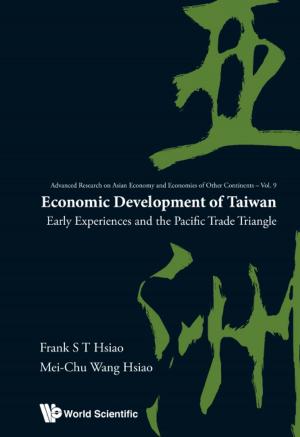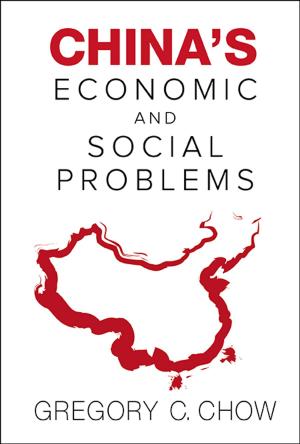Emerging Capital Markets and Transition in Contemporary China
Business & Finance, Economics, International Economics, Nonfiction, Social & Cultural Studies, Political Science, Politics, Economic Conditions| Author: | Ken Morita | ISBN: | 9789813148123 |
| Publisher: | World Scientific Publishing Company | Publication: | March 17, 2017 |
| Imprint: | WSPC | Language: | English |
| Author: | Ken Morita |
| ISBN: | 9789813148123 |
| Publisher: | World Scientific Publishing Company |
| Publication: | March 17, 2017 |
| Imprint: | WSPC |
| Language: | English |
This book provides the analysis on capital markets in China, focusing attention upon (1) the bubble phenomena (whether or not a Chinese bubble really exists and might burst), (2) foreign direct investment and (3) integration, through all of which we could recognize the current situation and the future prospects of Chinese marketization. As regards to the bubble phenomena, particularly 'early warning indicator' of the bubble, this book attempts to utilize the Grubbs-Smirnov Test to discover the 'abnormal value' in several asset markets. Investigations of this book suggest that the distinctive features of the Chinese market have been significantly different from the markets of capitalist countries such as the United States and Japan. As far as Japan's foreign direct investments in China are concerned, this book tries to reveal the Chinese characteristics on FDI phenomena with FDI-trade ratio. The analysis of this book suggests that Chinese FDI from Japan has undoubtedly revealed the distortions caused by non-economic factors, which also mean that the distinctive features of the Chinese market have been different from the markets of the United States and Japan etc. Regarding integration, this book provides the analysis on the 'G2' system between the United States and China (cooperation or conflict between them). The considerations of this book conclude that it might be difficult to have good cooperation between them because of significant differences between the Chinese system and the US system.
Contents:
-
Political Economy of Bubble Phenomena in China:
- A Comparative Analysis of Chinese Bubble with Japanese Bubble
- Bubble Phenomena and Path Dependence in China
- State Capitalism and Bubble Phenomena in China
- A Political Economy of Systemic Transition and Bubble Phenomena: A Comparison of China with Hungary
-
Political Economy of Internationalization in China:
- A Political Economy of Chinese Outward Foreign Direct Investment
- Political Economy of Regional Integration Between Yangtze River Delta Area and Chugoku District
- A Political Economy of FDI, Integration and Path Dependence
- A Political Economy of US–Japan Relations and US–China Relations
Readership: Students and researchers who are interested to understand the current situation as well as the future prospects of China's marketization.
This book provides the analysis on capital markets in China, focusing attention upon (1) the bubble phenomena (whether or not a Chinese bubble really exists and might burst), (2) foreign direct investment and (3) integration, through all of which we could recognize the current situation and the future prospects of Chinese marketization. As regards to the bubble phenomena, particularly 'early warning indicator' of the bubble, this book attempts to utilize the Grubbs-Smirnov Test to discover the 'abnormal value' in several asset markets. Investigations of this book suggest that the distinctive features of the Chinese market have been significantly different from the markets of capitalist countries such as the United States and Japan. As far as Japan's foreign direct investments in China are concerned, this book tries to reveal the Chinese characteristics on FDI phenomena with FDI-trade ratio. The analysis of this book suggests that Chinese FDI from Japan has undoubtedly revealed the distortions caused by non-economic factors, which also mean that the distinctive features of the Chinese market have been different from the markets of the United States and Japan etc. Regarding integration, this book provides the analysis on the 'G2' system between the United States and China (cooperation or conflict between them). The considerations of this book conclude that it might be difficult to have good cooperation between them because of significant differences between the Chinese system and the US system.
Contents:
-
Political Economy of Bubble Phenomena in China:
- A Comparative Analysis of Chinese Bubble with Japanese Bubble
- Bubble Phenomena and Path Dependence in China
- State Capitalism and Bubble Phenomena in China
- A Political Economy of Systemic Transition and Bubble Phenomena: A Comparison of China with Hungary
-
Political Economy of Internationalization in China:
- A Political Economy of Chinese Outward Foreign Direct Investment
- Political Economy of Regional Integration Between Yangtze River Delta Area and Chugoku District
- A Political Economy of FDI, Integration and Path Dependence
- A Political Economy of US–Japan Relations and US–China Relations
Readership: Students and researchers who are interested to understand the current situation as well as the future prospects of China's marketization.















